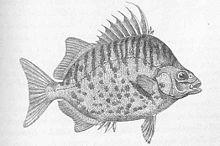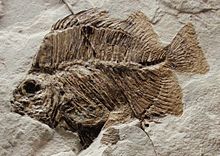Argus fish
| Argus fish | ||||||||||||
|---|---|---|---|---|---|---|---|---|---|---|---|---|

Common argus fish ( Scatophagus argus ) |
||||||||||||
| Systematics | ||||||||||||
|
||||||||||||
| Scientific name | ||||||||||||
| Scatophagidae | ||||||||||||
| Bleeker , 1876 |
The family of the Argus fish (Scatophagidae gr .: skatos = excrement, phagein = eat) consists of two genera and four species . They live in the tropical Indo-Pacific in the coastal sea and in brackish water , sometimes also in fresh water , often in river mouths and ports. The 10 to 38 cm long animals live gregariously in small groups. They feed on algae, detritus and also excrement (scientific name). "Scatophagidae" as a fly family (the Brachycera ) is valid to write Scathophagidae (sd).
features
Their shape is similar to that of the butterfly fish . Her body is flattened on the sides, almost rectangular and high. The head is pointed and the mouth is small and cannot be extended. There is a deep incision between the hard and soft rayed part of the dorsal fin. After the larval stage, the animals have strong head armor for some time ( Tholichthys stage). The color is silvery white (yellowish to brownish), with dark round spots of different sizes (interpreted as the eyes of the giant Argos ). 11 trunk, 12 caudal vertebrae.
Fin formula : dorsal XI – X / 15–18, anal IV / 14–17, caudal 16.
In young Argus fish, the fin spines of the dorsal, anal and ventral fins are provided with a thin, very thin glandular tissue that runs in two grooves. People who stab themselves feel a stabbing pain that goes away after a short time. As the Argus fish get older, the glandular tissue recedes.
Genera and species
- Genus Scatophagus Cuvier in Cuvier and Valenciennes, 1831
- Common argus fish ( Scatophagus argus ) (Linnaeus, 1766), up to 38 cm long, lives in the Persian Gulf and the Indo-Pacific : in the north to southern Japan , in the south to New Caledonia .
- African argus fish ( Scatophagus tetracanthus ) (Lacépède, 1802), up to 38 cm long, Indo-Pacific: From Somalia to South Africa , to Australia and New Guinea . In East Africa also in rivers and lagoons .
- Genus Selenotoca Myers, 1936
- Dot-stripe Argusfish ( Selenotoca multifasciata ) (Richardson, 1846), up to 40 cm long, Sulawesi , Indonesia , Western and Eastern Australia, and New Caledonia.
- Selenotoca papuensis Fraser-Brunner, 1938, 9 cm, Sulawesi and New Guinea.
Fossil record
The fossil Argus fish Scatophagus frontalis is known from the middle Eocene of the northern Italian Monte Bolca formation, which arose from Tethys deposits .
Aquarium keeping
Argus fish are sold as freshwater ornamental fish in specialist aquarium stores. In the long term, however, they can only be kept healthy in brackish or saltwater aquariums and they also become too big for home aquariums. Due to their voracity and very active metabolism, a strong filter and / or protein skimmer is necessary.
literature
- Joseph S. Nelson : Fishes of the World. 4th edition. John Wiley & Sons, Hoboken NJ et al. 2006, ISBN 0-471-25031-7 .
- Paolo Parenti: Annotated Checklist of Fishes, Family Scatophagidae Bleeker 1876, California Academy of Sciences, Number 36, February 2004, ISSN 1545-150X
Web links
- Argus fish on Fishbase.org (English)
Individual evidence
- ^ Matthias Bergbauer, Robert Myers, Manuela Kirschner: The cosmos manual dangerous sea animals. Kosmos Stuttgart, 2008, ISBN 978-3-440-10945-8
- ^ Karl Albert Frickhinger: Fossil Atlas Fish , Mergus-Verlag, Melle, 1999, ISBN 3-88244-018-X

